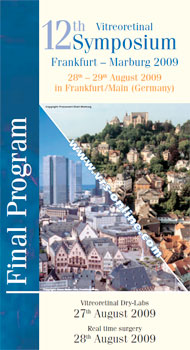12th Vitreoretinal Symposium Frankfurt – Marburg 2009
Scientific programm: Abstract
1st scientific session: Interface Macular Hole
5. Spectral Domain OCT
– Critical Evaluation of Different Systems
 Peter K. Kaiser (Cleveland)
Peter K. Kaiser (Cleveland)
Few people realize that optical coherence tomography (OCT) was not even a secondary endpoint in the pivotal, multicenter clinical trials for ranibizumab (Lucentis, Genentech, South San Francisco, CA). It was an after-thought that was performed at a few select centers. However, in the era of anti-VEGF agents, physician now use OCT in almost every case of age related macular degeneration (AMD) and other retinal vascular diseases such as diabetic retinopathy and retinal vascular occlusions, with a consequent dramatic drop in our use of fluorescein angiography. Until recently, we relied on interpreting time-domain OCT scans from the Stratus OCT (Carl Zeiss Meditec, Dublin, CA). The recent introduction of spectral domain OCT (SD-OCT) has dramatically increased acquisition speed and improved axial resolutions. SD-OCT offers several truly revolutionary improvements over Stratus for physicians. This lecture will critically compare the new SD-OCT systems including the Bioptogen 3D SDOCT (Bioptogen, Raleigh, NC), Heidelberg Spectralis (Heidelberg Engineering, Heidelberg, Germany), Topcon 3D OCT-1000 (Topcon Inc., Paramus, NJ), Opko Spectral OCT/SLO (Opko, Miami, FL), Cirrus (Carl Zeiss Meditec, Dublin, CA), Canon/Optopol Copernicus and Copernicus HR (Optopol, Poland), and the RTVue-100 (Optovue, Freemont, CA). Features, advantages, and disadvantages will be discussed.
Financial Disclosure:
Dr Kaiser serves on the scientific advisory boards of Carl Zeiss Meditec and Heidelberg Engineering.
Copyright © VRS-online, 1999-.
All rights reserved. Impressum, rechtliche Hinweise
HTML & Webdesign: SPALLEK.COM
